inflation pressure Lancia Delta 2015 Owner handbook (in English)
[x] Cancel search | Manufacturer: LANCIA, Model Year: 2015, Model line: Delta, Model: Lancia Delta 2015Pages: 291, PDF Size: 6.74 MB
Page 25 of 291
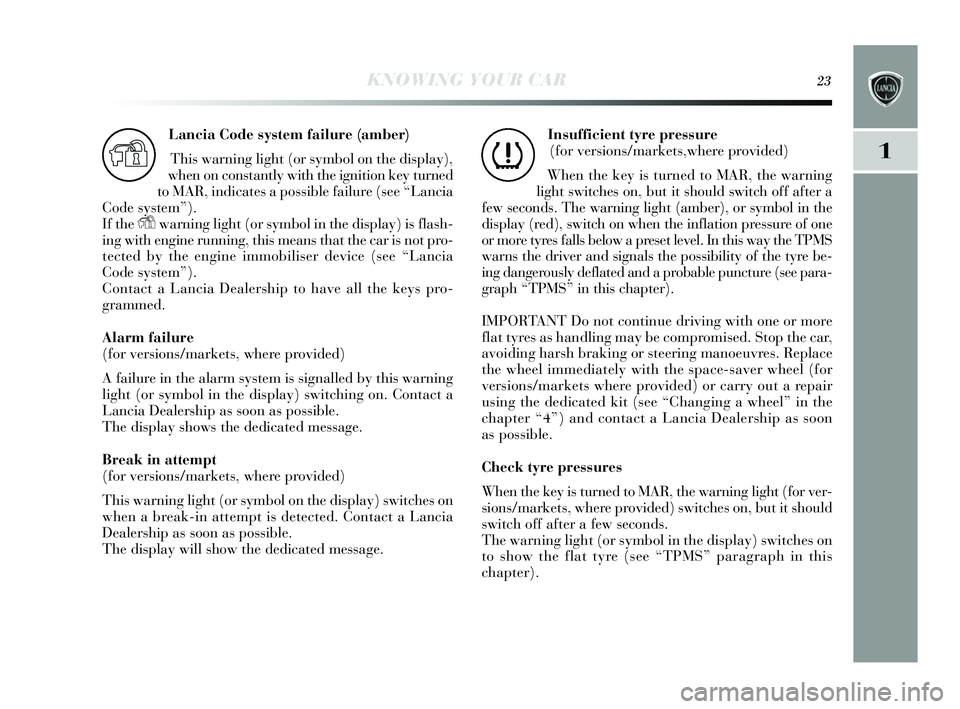
KNOWING YOUR CAR23
1
Lancia Code sy stem failure (amber)
This warning light (or symbol on the display ),
when on cons tantly with the ignition key turned
to MAR, indicates a possible failure ( see “Lancia
Code system”).
If the
Ywarning light (or symbol in the display) is flas h-
ing with engine running, this means that the car is not pro-
tected by the engine immobilis er device (see “Lancia
Code system”).
Contact a Lancia Dealer ship to have all the keys pro-
grammed.
Alarm failure
(for vers ions/markets , where provided)
A failure in the alarm system is s ignalled by this warning
light (or symbol in the display) switching on. Contact a
Lancia Dealer ship as soon as possible.
The dis play shows the dedicated message.
Break in attempt
(for vers ions/markets , where provided)
This warning light (or symbol on the dis play) switches on
when a br
eak-in attempt is detected. Contact a Lancia
Dealers hip as soon as possible.
The dis play will s how the dedicated me ssage.
Y
Insufficient tyre pressure
(for vers ions/markets ,where provided)
When the key i s turned to MAR, the warning
light switches on, but it s hould switch off after a
few seconds . The warning light (amber), or symbol in the
dis play (red), switch on when the inflation pre ssure of one
or more ty res falls below a pres et level. In this way the TPMS
warns the driver and s ignals the possibility of the tyre be-
ing dangerous ly deflated and a probable puncture (s ee para-
graph “TPMS ” in this chapter).
IMPORTANT Do not continue driving with one or more
flat tyre s as handling may be compromised. Stop the car,
avoiding har sh braking or steering manoeuvres. Replace
the wheel immediately with the space-saver wheel (for
vers ions /markets wher
e provided) or carr y out a repair
u sing the dedicated kit ( see “Changing a wheel” in the
chapter “4”) and contact a Lancia Dealer ship as s oon
as possible.
C heck ty re pressures
When the key is turned to MAR, the warning light (for ver-
s ions /markets , where provided) s witches on, but it s hould
s witch off after a few s econds.
The warning light (or symbol in the dis play) switches on
to show the flat ty re (see “TPMS ” paragraph in thi s
chapter).
n
001-154 Delta GB 1ed 03/03/14 10.00 Pagina 23
Page 26 of 291
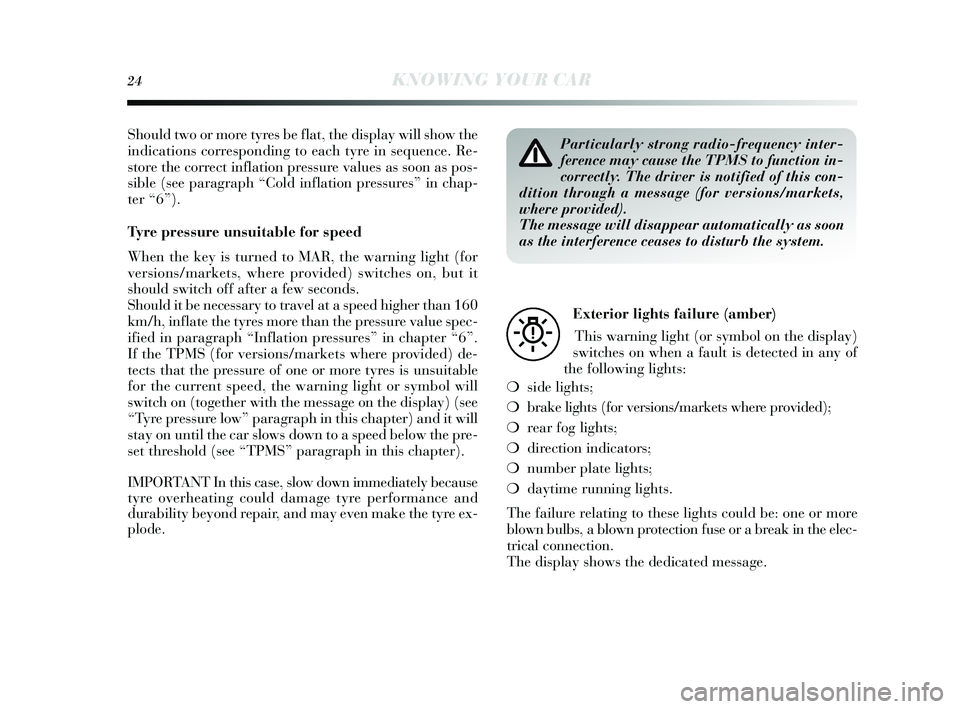
24KNOWING YOUR CAR
Should two or more ty res be flat, the dis play will s how the
indications corresponding to each ty re in sequence. Re-
s tore the correct inflation pre ssure values as s oon as pos-
s ible (s ee paragraph “Cold inflation pre ssures” in chap-
ter “6”).
T yre pressure unsuitable for speed
When the key is turned to MAR, the warning light (for
vers ions /markets , where provided) s witches on, but it
s hould switch off after a few s econds.
S hould it be necessary to travel at a speed higher than 160
km/h, inflate the t yre s more than the pressure value s pec-
ified in paragraph “Inflation pressures” in chapter “6”.
If the TPMS (for versions/markets where provided) de-
tects that the pr
essure of one or more t yre s i s uns uitable
for the current s peed, the warning light or symbol will
s witch on (together with the message on the di splay ) (see
“T yre pre ssure low” paragraph in this chapter) and it will
s tay on until the car s lows down to a s peed below the pre-
s et thres hold (see “TPMS ” paragraph in thi s chapter).
IMPORTANT In this case, slow down immediately because
t y re overheating could damage t yre performance and
durability beyond repair, and may even make the tyre ex-
plode.
Particularly strong radio-frequency inter-
ference may cause the TPMS to function in-
correctly. The driver is notified of this con-
dition through a message (for versions/markets,
where provided).
The message will disappear automatically as soon
as the interference ceases to disturb the system.
Exterior lig hts failure (amber)
This warning light (or symbol on the display)
s witches on when a fault i s detected in any of
the following lights :
❍ side lights ;
❍ brake lights (for versions/markets where provided);
❍ rear fog light s;
❍ direction indicators ;
❍ number plate light s;
❍ day time running light s.
The failure relating to the se lights could be: one or more
blown bulbs , a blown protection fus e or a break in the elec-
trical connection.
The dis play shows the dedicated message.
W
001-154 Delta GB 1ed 03/03/14 10.00 Pagina 24
Page 129 of 291

KNOWING YOUR CAR127
1
IMPORTANT The steering may become slightly stiff fol-
lowing parking manoeuvres involving a lot of steering.
This is normal and is caused by a system to prevent the
motor from overheating. No servicing is required. The
power steering system will s tart working normall y again
the next time the car is used.TPMS SYSTEM
(Tyre Pressure Monitoring System)
(for vers ions/markets , where provided)
The car may be equipped with a TPMS (Tyre Pre ssure
Monitoring System). This system compris es a radio fre-
quency transmitter fitted to each wheel (on the wheel rim
ins ide the ty re), which i s able to send information on the
t y re inflation pressure of each wheel to the control unit.
IMPORTANT NOTES ABOUT THE TPMS
The fault indication s are not s tored and will therefore
not be dis played after the engine ha s been s witched off
and then on again. If the fault condition s pers is t, the con-
trol unit will s end the relative indication s to the ins tru-
ment panel only after the car ha s been in motion for a
s hort time.
Before starting any servicing operation, stop
the engine and remove the key from the ig-
nition switch to operate the steering lock, par-
ticularly when the wheels do not touch the ground.
If this is not possible (i.e. if the key must be kept
in the MAR position or the engine must be kept run-
ning), remove the main electric power steering sys-
tem fuse.
001-154 Delta GB 1ed 03/03/14 10.00 Pagina 127
Page 130 of 291

128KNOWING YOUR CAR
The TPMS cannot indicate sudden tyre pres-
sure drops (for example when a tyre blows
out). In this case stop the car, braking with
care and avoiding sharp steering actions.
Replacing the normal tyres with winter tyres
and vice versa requires the inspection of the
TPMS, which should only be carried out by
a Lancia Dealership.
The TPMS requires the use of specific equip-
ment. Contact a Lancia Dealership to find out
which accessories are compatible with the
system (wheels, hub caps etc.). The use of other ac-
cessories may affect the normal operation of the sys-
tem.
Tyre inflation pressure may vary according
to outdoor temperature. The TPMS may tem-
porarily indicate insufficient pressure. In this
case, check the tyre pressures with the tyres cold
and, if necessary, restore the inflation values.
The tyre repair kit (Fix&Go Automatic) pro-
vided with the car is compatible with the
TPMS sensors; using sealants not equiva-
lent with that in the original kit may adversely af-
fect its operation. If sealants not equivalent with
the original one are used, it is recommended to
have the TPMS sensors checked by a qualified re-
pair centre.
001-154 Delta GB 1ed 03/03/14 10.00 Pagina 128
Page 194 of 291
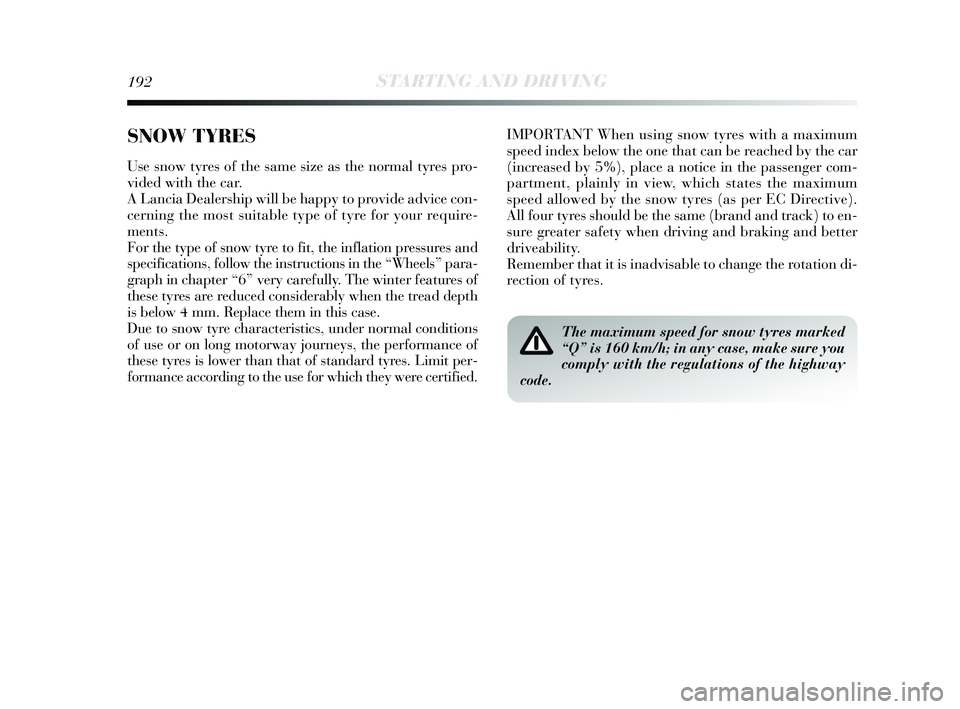
192STARTING AND DRIVING
IMPORTANT When using snow tyres with a maximum
speed index below the one that can be reached by the car
(increased by 5%), place a notice in the passenger com-
partment, plainly in view, which states the maximum
speed allowed by the snow tyres (as per EC Directive).
All four tyres should be the same (brand and track) to en-
sure greater safety when driving and braking and better
driveability.
Remember that it is inadvisable to change the rotation di-
rection of tyres.
The maximum speed for snow tyres marked
“Q” is 160 km/h; in any case, make sure you
comply with the regulations of the highway
code.
SNOW TYRES
Use snow tyres of the same size as the normal tyres pro-
vided with the car.
A Lancia Dealership will be happy to provide advice con-
cerning the most suitable type of tyre for your require-
ments.
For the type of snow tyre to fit, the inflation pressures and
specifications, follow the instructions in the “Wheels” para-
graph in chapter “6” very carefully. The winter features of
these tyres are reduced considerably when the tread depth
is below 4 mm. Replace them in this case.
Due to snow tyre characteristics, under normal conditions
of use or on long motorway journeys, the performance of
these tyres is lower than that of standard tyres. Limit per-
formance according to the use for which they were certified.
183-194 Delta GB 1ed 26/08/13 12.15 Pagina 192
Page 203 of 291

IN AN EMERGENCY201
4
❍make sure that switch C - fig. 5 for the compressor is
in position 0 (off), start the engine, insert pin E - fig.
5a into the power socket and switch on the compres-
sor by placing switch C - fig. 5 in position I (on);
❍ inflate the tyre to the pressure specified in the “Infla-
tion pressure” paragraph, in chapter “6”. For a more
accurate reading, check pressure value on pressure
gauge D - fig. 5 with the compressor off;
❍ if after 5 minutes you cannot reach at least 1.5 bar, un-
plug the compressor from the valve and the power
socket, then move the car forward about 10 metres in
order to distribute the sealant inside the tyre evenly,
then repeat the inflation operation;
fig. 5L0E0078mfig. 5aL0E0288m
❍if after this operation it is still not possible to reach at
least 1.8 bar after 5 minutes, do not start driving since
the tyre is excessively damaged and the quick tyre re-
pair kit cannot guarantee suitable sealing. Contact a
Lancia Dealership;
❍ if the tyre reaches the pressure specified in the “Infla-
tion pressure” paragraph in chapter “6”, start driving
immediately;
Apply the adhesive label in a position clear-
ly visible by the driver as a reminder that the
tyre has been treated with the quick repair
kit. Drive carefully, particularly on bends. Do not
exceed 80 km/h. Do not accelerate or brake sud-
denly.
195-232 Delta GB 1ed 03/03/14 09.14 Pagina 201
Page 206 of 291
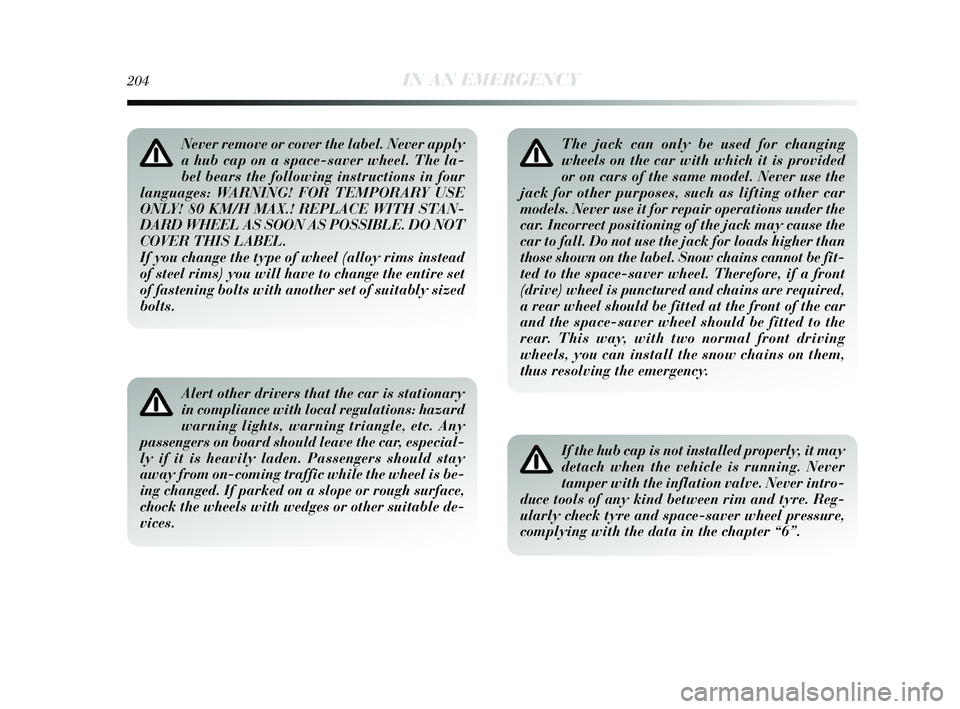
Never remove or cover the label. Never apply
a hub cap on a space-saver wheel. The la-
bel bears the following instructions in four
languages: WARNING! FOR TEMPORARY USE
ONLY! 80 KM/H MAX.! REPLACE WITH STAN-
DARD WHEEL AS SOON AS POSSIBLE. DO NOT
COVER THIS LABEL.
If you change the type of wheel (alloy rims instead
of steel rims) you will have to change the entire set
of fastening bolts with another set of suitably sized
bolts.
Alert other drivers that the car is stationary
in compliance with local regulations: hazard
warning lights, warning triangle, etc. Any
passengers on board should leave the car, especial-
ly if it is heavily laden. Passengers should stay
away from on-coming traffic while the wheel is be-
ing changed. If parked on a slope or rough surface,
chock the wheels with wedges or other suitable de-
vices.
204IN AN EMERGENCY
The jack can only be used for changing
wheels on the car with which it is provided
or on cars of the same model. Never use the
jack for other purposes, such as lifting other car
models. Never use it for repair operations under the
car. Incorrect positioning of the jack may cause the
car to fall. Do not use the jack for loads higher than
those shown on the label. Snow chains cannot be fit-
ted to the space-saver wheel. Therefore, if a front
(drive) wheel is punctured and chains are required,
a rear wheel should be fitted at the front of the car
and the space-saver wheel should be fitted to the
rear. This way, with two normal front driving
wheels, you can install the snow chains on them,
thus resolving the emergency.
If the hub cap is not installed properly, it may
detach when the vehicle is running. Never
tamper with the inflation valve. Never intro-
duce tools of any kind between rim and tyre. Reg-
ularly check tyre and space-saver wheel pressure,
complying with the data in the chapter “6”.
195-232 Delta GB 1ed 03/03/14 09.14 Pagina 204
Page 212 of 291
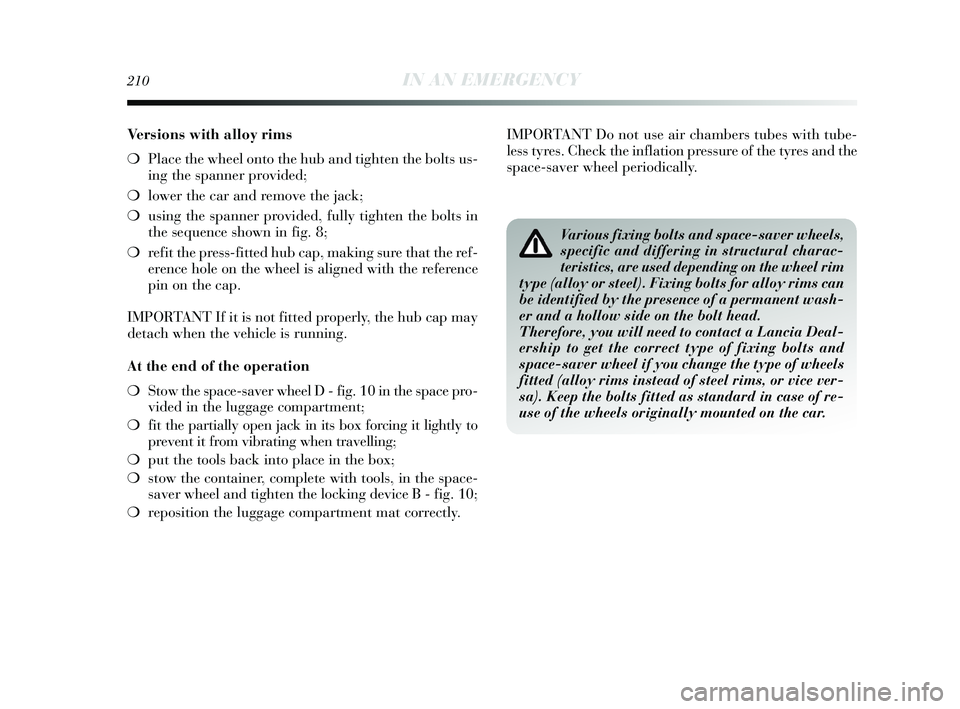
210IN AN EMERGENCY
Versions with alloy rims
❍Place the wheel onto the hub and tighten the bolts us-
ing the spanner provided;
❍ lower the car and remove the jack;
❍ using the spanner provided, fully tighten the bolts in
the sequence shown in fig. 8;
❍ refit the press-fitted hub cap, making sure that the ref-
erence hole on the wheel is aligned with the reference
pin on the cap.
IMPORTANT If it is not fitted properly, the hub cap may
detach when the vehicle is running.
At the end of the operation
❍ Stow the space-saver wheel D - fig. 10 in the space pro-
vided in the luggage compartment;
❍ fit the partially open jack in its box forcing it lightly to
prevent it from vibrating when travelling;
❍ put the tools back into place in the box;
❍ stow the container, complete with tools, in the space-
saver wheel and tighten the locking device B - fig. 10;
❍ reposition the luggage compartment mat correctly. IMPORTANT Do not use air chambers tubes with tube-
less tyres. Check the inflation pressure of the tyres and the
space-saver wheel periodically.
Various fixing bolts and space-saver wheels,
specific and differing in structural charac-
teristics, are used depending on the wheel rim
type (alloy or steel). Fixing bolts for alloy rims can
be identified by the presence of a permanent wash-
er and a hollow side on the bolt head.
Therefore, you will need to contact a Lancia Deal-
ership to get the correct type of fixing bolts and
space-saver wheel if you change the type of wheels
fitted (alloy rims instead of steel rims, or vice ver-
sa). Keep the bolts fitted as standard in case of re-
use of the wheels originally mounted on the car.
195-232 Delta GB 1ed 03/03/14 09.15 Pagina 210
Page 249 of 291

WHEELS AND TYRES
Check the pressure of each tyre, including the space-saver
wheel, approximately every two weeks and before long
journeys: the pressure should be checked with the tyre rest-
ed and cold.
It is normal for the pressure to increase as the car is used;
see the “Wheels” paragraph in chapter “6” for the correct
tyre inflation pressure.
Incorrect pressure causes abnormal tyre wear fig. 2:
A normal pressure: tread evenly worn.
B low pressure: tread particularly worn at the edges.
C high pressure: tread particularly worn in the centre.
The tyres must be replaced when the tread is less than 1.6
mm thick. In any case, follow the laws in force in the coun-
try you are in.
fig. 2L0E0096m
IMPORTANT
❍Where possible, avoid braking suddenly, wheel-spin-
ning and crashing into curbs, potholes or other ob-
stacles. Driving for long stretches over bumpy roads
can damage the tyres;
❍ check the tyres regularly for cuts on the sides, swellings
or irregular tread wear. Go to a Lancia Dealership if
required.
❍ avoid overloading the car when travelling: this may
cause serious damage to the wheels and tyres;
❍ if a tyre is punctured, stop immediately and change it
to avoid damage to the tyre, wheel rim, suspension and
steering system;
❍ the tyre ages even if rarely used. Cracks in the tread and
on the side walls are a sign of ageing. Have the tyres
checked by specialised personnel if they have been fit-
ted for longer than 6 years. Remember to check the
space-saver wheel very carefully;
❍ when replacing the tyres, always fit new tyres, avoid-
ing those of dubious origin;
MAINTENANCE AND CARE247
233-256 Delta GB 1ed 03/04/14 13:28 Pagina 247
Page 250 of 291

248MAINTENANCE AND CARE
❍if a tyre is replaced, you should also change the infla-
tion valve;
❍ to allow even wear between the front and rear tyres,
it is advisable to change them over every 10-15 thou-
sand kilometres, keeping them on the same side of the
car so as not to reverse the direction of rotation.
Remember that the road holding qualities of
your car also depend on the correct inflation
pressure of the tyres.
If the pressure is too low the tyre will get
overheated, with the risk of serious damage
to the tyre.
Avoid moving the tyres from the right side of
the vehicle to the left side and vice versa.
Do not repaint alloy wheel rims at temper-
atures higher than 150°C. The mechanical
specifications of the wheels might be ad-
versely affected.
233-256 Delta GB 1ed 03/04/14 13:28 Pagina 248